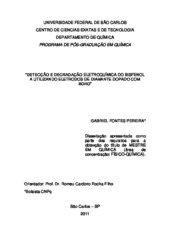Detecção e degradação eletroquímica do bisfenol A utilizando eletrodos de diamante dopado com boro
Abstract
The electrochemical detection of bisphenol A (BPA) by differential pulse voltammetry (DPV) using a boron-doped diamond (BDD) electrode was developed. A 0.5 mol L 1 H2SO4 solution was used as supporting electrolyte and the DPV parameters (modulation amplitude, scan rate, and modulation time) were optimized. The voltammetries presented adequate repeatability and reproducibility, and the obtained analytical curve (range 0.44 5.2 μmol L 1) presented good linearity (R2 = 0.999), yielding a detection limit of 0.21 μmol L 1. For the electrochemical degradation of BPA (150 mg L 1) using a Nb/BDD electrode in a filter-press reactor, the effect of volumetric flow rate, temperature, pH, and current density (j) in a 0.1 mol L 1 solution was investigated. A positive effect of volumetric flow rate and temperature increases on the COD removal was observed; the pH did not present a significant effect (thus, its value was fixed at 6). By determining the mass-transport coefficient of the system, it was possible to obtain the value of jlim (12 mA cm 2). Thus, for j > jlim, in the absence of Cl ions in solution, the DQO decay was typical of a mass-transfer limited process, while for j < jlim a behavior typical of a charge-transfer limited process was observed. In terms of electrolysis time, the best condition was for j > jlim, whereas in terms of instantaneous current efficiency the best condition was for j = 6,5 mA cm 2. In the presence of Cl ions in solution (1.5 g L 1) using 30 mA cm-2, a significant improvement in the electrolysis time necessary for 90 % COD removal (65 min) was observed due to the electrogeneration of species such as HOCl and OCl (predominant active chlorine species at pH 6); for j = 6.5 mA cm 2 no improvement was observed, but the best average current efficiency was attained (58 %). Determinations of COT decay, in the presence and absence of Cl ions in solution, using 30 and 6.5 mA cm 2, presented characteristics similar to those of the COD decay under the same conditions. Compared to other electrodes (Ti-Pt/β-PbO2 and RuTiO2), both in the absence and presence of Cl ions in solution, the performance of the Nb/BDD electrode proved to be superior to those of the others. Using a TiRuO2 electrode, significant COD reduction was attained only in the presence of Cl ions in solution.
